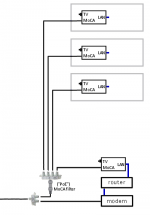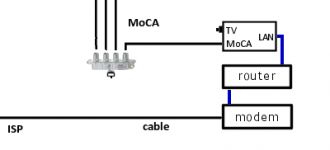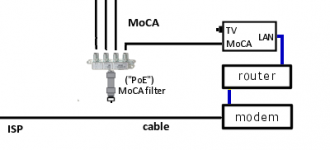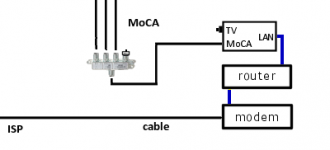rpmartinez1987
Regular Contributor
I'm helping out a co-worker redo his home internet by installing multiple Access points and hard wiring all of his streaming boxes, PCs and game consoles.
I'm going to use Moca for all of this.
Before, I go off buying things just wanted to run this setup by you guys.
His internet line (200 Mbps) comes in from one end of his basement to another and then immediately goes up to the Spectrum All in One Modem, Router, Access Point, telephone box,
that is installed in his wife's office on the 1st floor of the 2 story house.
My plan is to split the incoming cable with a 2-Way MOCA 5-1675Mhz Splitter.
One end would go straight to the modem and the other will go into the INPUT port of the PPC Entry Series Active Return 9-Port MoCA Amplifier Model: PPC-9M-U/U
The reason for this split is because right now he has a Docsis 3.0 modem but one day it might be 3.1
I, then plan on connecting the MOCA adapter to one of the LAN ports on the modem/router and connecting the coax end of the adapter to the Passive (voice) Out Port.
I would then connect the Coax cables that lead to the multiple rooms in the house to the remaining output ports of the PPC-9M-U/U.
On the other end I'll connect a MOCA adapter to either access points, switches or streaming boxes.
Will this setup work? And do you guys have any Moca brand adapter recommendations.
I'm planning on going with Actiontec but would like to know your thoughts on other recommendations.
Thanks
I'm going to use Moca for all of this.
Before, I go off buying things just wanted to run this setup by you guys.
His internet line (200 Mbps) comes in from one end of his basement to another and then immediately goes up to the Spectrum All in One Modem, Router, Access Point, telephone box,
that is installed in his wife's office on the 1st floor of the 2 story house.
My plan is to split the incoming cable with a 2-Way MOCA 5-1675Mhz Splitter.
One end would go straight to the modem and the other will go into the INPUT port of the PPC Entry Series Active Return 9-Port MoCA Amplifier Model: PPC-9M-U/U
The reason for this split is because right now he has a Docsis 3.0 modem but one day it might be 3.1
I, then plan on connecting the MOCA adapter to one of the LAN ports on the modem/router and connecting the coax end of the adapter to the Passive (voice) Out Port.
I would then connect the Coax cables that lead to the multiple rooms in the house to the remaining output ports of the PPC-9M-U/U.
On the other end I'll connect a MOCA adapter to either access points, switches or streaming boxes.
Will this setup work? And do you guys have any Moca brand adapter recommendations.
I'm planning on going with Actiontec but would like to know your thoughts on other recommendations.
Thanks





